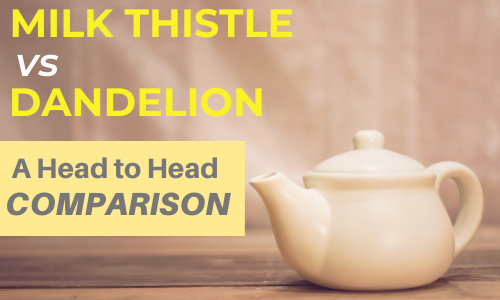Even before the dawn of the 1st century when the Greeks dominated “modern” health practices, milk thistle and dandelion were already favorites of physicians.
Although their mechanisms of action weren’t well known in those days, anecdotal evidence suggested these herbs were potent cleansers and purifiers of the human body.
Nowadays, we have the science to back them up. As studies have shown, milk thistle and dandelion are among the best herbs for detoxing and supporting liver function.
But how do they compare?
Let’s see.
What’s the Difference Between Milk Thistle and Dandelion?
Some of the differences are physical while others can be seen in their usage and pharmacokinetic properties (aka how they work in the body).
Even though both dandelion and milk thistle have very similar outcomes and effects, how they achieve them is where their differences lie:
1. Different parts are used
With milk thistle, the whole plant has therapeutic benefits. With dandelion, on the other hand, it’s primarily the root that lends its benefits.
While you can make milk thistle tea using its leaves, prepare a delicacy using its stems, or even make a salad, such diversity isn’t as common with dandelion root.
Although, you can toss some dandelion greens in your salad for added nutrition.
But back to milk thistle, even its seeds can be useful. Some people actually roast them and enjoy as a healthy coffee substitute.
2. Their mechanism of action is different
Studies have shown that milk thistle improves the regenerative potential of your liver.
The liver is a very forgiving organ. When damaged, it can regenerate through a process where new cells are produced to replace damaged cells.
That entire process is greatly enhanced by milk thistle.
Dandelion root, on the other hand, increases the secretory potential of the liver – especially in the production and secretion of bile.
So basically, milk thistle supports the health of the liver while dandelion boosts its function.
3. They have different active ingredients
Part of the reason why these herbs work differently is because of their active ingredients.
Silymarin is the active ingredient in milk thistle and is responsible for most of its beneficial effects.
In dandelion root, the active ingredient is carbon tetrachloride.
Now that we’ve honed in on a few of their differences, let’s take a closer look at the benefits each herb has to offer.
Benefits Of Dandelion
Most of dandelion’s benefits are due to its ability to increase the liver’s secretion of bile. There are others though, and we’ll discuss those as well.
1. Dandelion enriches the liver with antioxidants
Oxidative stress is one of the primary causes of liver damage. This occurs when free radicals produced in the liver during metabolism are not adequately neutralized.
Dandelion is helpful in this arena thanks to its beta carotene content, which acts as an antioxidant.
2. Dandelion aids in weight loss
A 2010 study revealed that chlorogenic acid (a component of dandelion) has the potential to reduce obesity and improve lipid metabolism in rats.
Although the study was animal-based, anecdotal evidence suggests that the same benefits can be achieved in humans.
3. Dandelion may reduce total body cholesterol
According to another 2010 study with rabbit subjects, consumption of both the leaves and roots of dandelion helped in lowering cholesterol - even after the animals were fed a high cholesterol diet.
Studies also show it may be useful as a natural remedy for nonalcoholic fatty liver disease.
Benefits Of Milk Thistle
Milk thistle is one of the most popular herbs in the field of detox and liver health. However, as you'll see, its health benefits are not limited to the liver.
1. Milk thistle helps regenerate liver cells
Milk thistle is one of the few herbs that can actively manage liver diseases such as cirrhosis and hepatitis.
In such conditions, liver cells are damaged. Some parts may even start to die off.
Fortunately, milk thistle helps improve the liver’s regenerative potential, making it possible for the liver to grow and compensate for damaged areas.
2. Milk thistle promotes healthy skin
According to this study published in 2015, milk thistle has potent anti-inflammatory effects that are helpful for inflammatory skin conditions.
Other studies show that milk thistle’s antioxidant content has anti-aging benefits that can make skin look younger and healthier.
3. Milk thistle reduces insulin resistance
For quite some time, milk thistle has been recommended for people with diabetes, especially Type 2 where the main concern is insulin resistance.
In this case, the body is producing enough insulin, but it’s not utilized properly by target tissues.
Interestingly enough, a 2016 study suggests that milk thistle may alleviate insulin resistance in rats.
However, since diabetes is a delicate disease, more studies are needed to confirm this claim before the use of milk thistle in this way can go mainstream.
Should I Use Milk Thistle Or Dandelion?
In many cases, both herbs are equally beneficial to the liver because their outcomes are similar.
However, there are situations where you might prefer one over the other.
For instance, if you have a liver disease where there’s a possibility of damage, the go-to option is milk thistle because it actively boosts the regenerative potential of the liver.
Moreover, patients with insulin resistance, fatty liver disease, and inflammatory conditions can also benefit from milk thistle.
But if your liver problems are primarily due to impaired secretion (like if you’re prone to bile stones), then dandelion may be best.
In many cases you don’t have to choose between the two. You can combine them for even more benefit.
The two work very well together because their actions are different, yet complementary.
Can I Substitute Dandelion for Milk Thistle and Vice Versa?
Yes! Dandelion is a sufficient substitute for milk thistle. As much as milk thistle is effective, it’s not as readily available as dandelion. So if you can’t get hold of milk thistle, you can opt for dandelion root instead.
Our opinion on the great milk thistle vs dandelion debate? Why pit them against each other - use together!
Unless your herbal practitioner advises otherwise, they are complementary herbs and can be used simultaneously for extra support.
But if you can’t get both, each can work as a substitute for the other.
One of our favorite ways to use these herbs are in tincture form - without alcohol. Try our vegan, glycerine-based Organic Milk Thistle or Liver Love Support today!


